Band Adjustment
Richard, here is my first pass at a version of the band adjustment page. However, there is something missing that MUST be addressed before publishing the page. That is what to do about bands that have the three bolts that fasten them to the dome and base.
Overview
The Kamado bands are adjusted carefully at our factory before shipment to provide a reasonably “airtight” seal between the base and the lid.
We do a “paper” test to see if a paper can be pulled out after the lid is closed. We adjust the bands until we are assured of a proper seal.
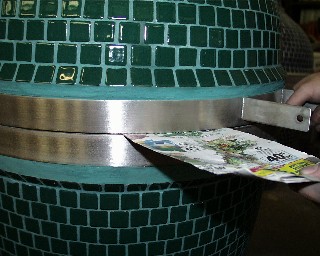
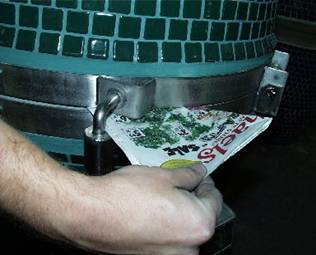
Often the Kamados travel long distances to their homes and sometimes sustain rough treatment that might require that the bands be readjusted for the proper seal. Also after years of considerable use the bands 4 bolts might need to be tightened or the bands adjusted and then tightened.
We might mention that ALL Kamado ceramic lids and bases have been surfaced. They do not become warped or uneven after use. I.e. the ceramic lid and base are “airtight.” If there is “leakage” it is NOT caused by the ceramic surfaces, but simply the bands have slipped and need adjustment. It would be hopeless to try to adjust bands to prevent air leaks if the mating surfaces were or would become warped.
Factory Band Adjustment Procedure
While assembling your new Kamado at our factory, we follow this procedure:
- Install the bands WITHOUT the springs in the props.
- Locate bands in the band seat, making sure the upper and lower bands are level with service of the base and lid... [See picture]
- Lightly tighten the 4 band bolts making sure the bands are flush (even) with the lid and base surfaces. [See picture]
- Tap the bands if necessary to assure the bands are together and flush with the surfaces
- Further tighten the 4 band bolts and do the paper test to assure there is no gaps in any location around the circumference of the Kamado, if so, tap the bands into position
- At this time tighten the 4 band bolts as tight as possible, without concern of over tightening and causing damage to the ceramic or the Kamado itself.
- Insert the compression springs and
- Do the final paper test to be assured of no gap between the lid and base.
- If the paper test indicates a slight gap this can be corrected by again tapping the bands in the direction needed. See examples of problem and suggested corrections infra.
Customer Adjustment of Bands in the Field
There are two methods of performing a band adjustment in the field, we'll call them "Major" and "Minor".
For a Minor band adjustment start at Step 7 of the Major procedure outlined below.
This “Major” procedure begins with Step 1 and is basically the same as performed in the factory when the bands are first installed or the bands have been removed for shipping or handling. The only special tool required is a wooden dowel with a slot cut in the end to allow the bolt to removed while holding the spring up in the tube.
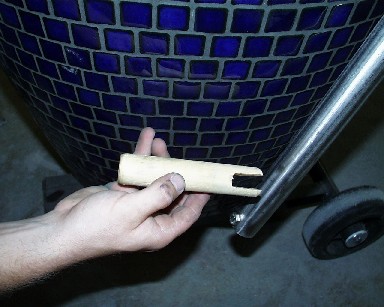
Step 1:
Raise the lid of the Kamado as high as possible and tighten both stopper handles on the spring prop tubes. This will securely hold the lid up.
Step 2:
At the bottom of each spring tube, use the dowel tool to push up the spring. Remove the bolt that holds the spring in place.
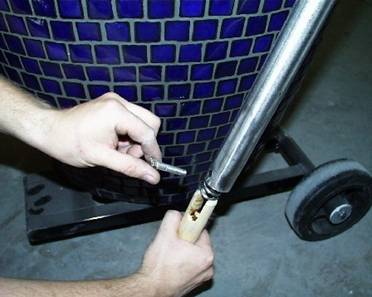
Step 3:
Loosen the stoppers and carefully lower the lid. Keep in mind that the springs are removed, so the lid will be heavy.
Raise and lower the lid and adjust the upper and lower bands until they are level with the rims of the base and lid, all around. This can be done by tapping the bands until they slide together and are even with the lid and base surfaces.
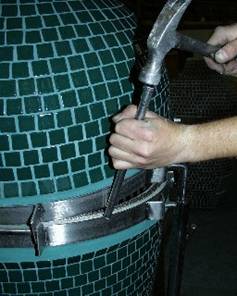
If tapping will not move the bands together, it might be necessary to loosen the band bolts slightly to allow the bands to slide so as to touch each other and then retighten.
Step 4:
Do the paper test to see if further adjustment (tapping) might be necessary. Raise and lower the lid several times to be assured there are no gaps.
We insert a folded sheet of newspaper or writing paper to test and make sure the paper cannot be pulled out at any location between the lid and base of the Kamado. This procedure indicate where any potential leaks are.
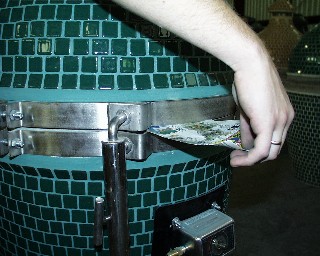
Step 5:
Tighten the band bolts as tight as possible. Sometimes new bolts might be required. We tighten the bolts until they and the bands form a 90 degree bend. This is the key step in a permanent band adjustment.
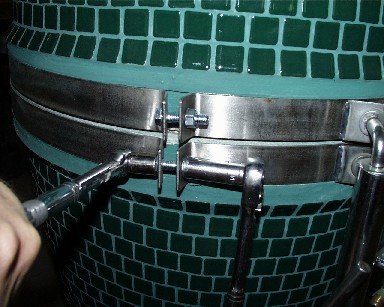
We know that tightening the bolts this tight might be concern you, and that you might think it could damage the ceramic walls or the Kamado itself, but it will not. Your Kamado's modulus of rupture or compressible strength is remarkable and will withstand this tremendous force
Step 6:
Raise the lid to its fullest, tighten the stoppers and insert the springs into the prop tubes. To insert the springs, use the a dowel or PVC pipe with a slot (as mentioned above) to push the spring into the prop tube far enough to insert the retaining bolt.

Step 7:
Loosen the stoppers, lower the lid and perform another "paper test." If there is a slight looseness in the paper test, this can be corrected by tapping the bands with the bolts tight and the springs in. See the examples below.
Examples of leaking (paper test) and suggested corrections:
- Front (at handle). Lid does not close all the way down.
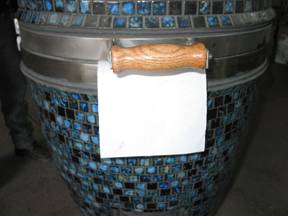
Correction: Tap the hinge upward. Alternating left hinge brace & right.
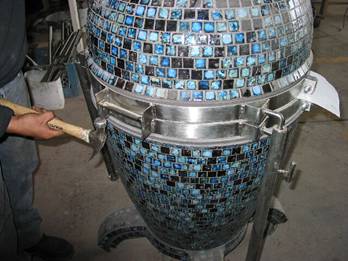
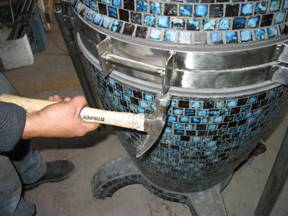
- Leaking at Hinge Area.
Correction: Tapping is done lightly with the band bolts TIGHT and springs IN. It is considered a final adjustment or minor adjustments after use for some time. Or in the case where shipping or moving has change the band position slightly. If it is difficult to tap the bands for adjustment, a slight loosing of the band bolts should be done. After adjustment and paper test the band bolts should be re-tightened or tightened.
Summary
Hopefully, this will be the last adjustment ever needed. However, sometime in the future it is possible to torque the bands sufficient to cause bands to slip. For example, having the lid held partly open with one prop stopper and leaning on the lid. In this case there is hundreds of pound torque twisting one side while the other is held firmly. Normal use should not require band adjustment.
Frequently Asked Questions
-
What tools are necessary?



-
If a complete band adjustment (removing the springs) or installing the bands after they have been removed would require a dowel or other such instrument, the size of the inside of the prop tube with a slot cut for the retaining bolt.
-
An ordinary hammer.
-
A simple devise to tap on such as a bar, bolt, pipe, rod, heavy screwdriver or similar are all good. Also a very piece of very hard wood works.
-
Two end wrenches to tighten the 4 band bolts.
-
-
How often is band adjustment necessary?
Possible once or twice a year. Often, never. On average, once every two years or after shipment or moving. -
How long does it take to do the adjustment of the bands?
Approximately 10 to 20 minutes where the springs have been removed. If only a slight leak in the paper test and springs remain in and bolts remain tight, it would only a minute or two. -
Is adjustment of the bands necessary if only a small leak of 1/32 of an inch or so? Or if a lot of “low and slow” cooking is desired and/or when the Temperature Controller (Guru or other) is used.
Nothing is damaged on the Kamado or the operation, by a small gap. However, maintain very low temperatures (under 200 degrees) or smothering the charcoal out after cooking it might be necessary to have a band adjustment. -
How do I know if the bands need adjustment?
Visually, the bands should be close together and are NOT above the surface of the lid and base. I.e. very little gap between the upper and lower metal bands. Excessive smoke between the bands (some smoke is normal when the lid is closed quickly with the damper and draft door closed.) Cardboard or paper test as discussed above. Charcoal does not smother out with damper and draft door closed. -
How long have there been Kamado adjustment issues?
From the day Richard designed the first bands 40 years ago. Prior to metal bands, we raised the lid by the ceramic handles cast in the lid. All Kamados, prior to our new Kamado design, did not have compression springs to assist in raising the heavy lid and provide the safety feature of preventing the lid from slamming down. Without compression springs, there is less tendency for the bands to slip. Careful adjustment of the bands is a small price to pay for the convince and safety of the prop assists. -
What is the most common problem in adjusting the bands?
Not tightening the 4 band bolts tight enough because customers fear that over tightening the bolts will damage the Kamado. This should not be a concern. -
What do I do if all my attempts to adjust fail?
A: Please call or email service@kamado.com. We have solved all unique band adjustment problems.